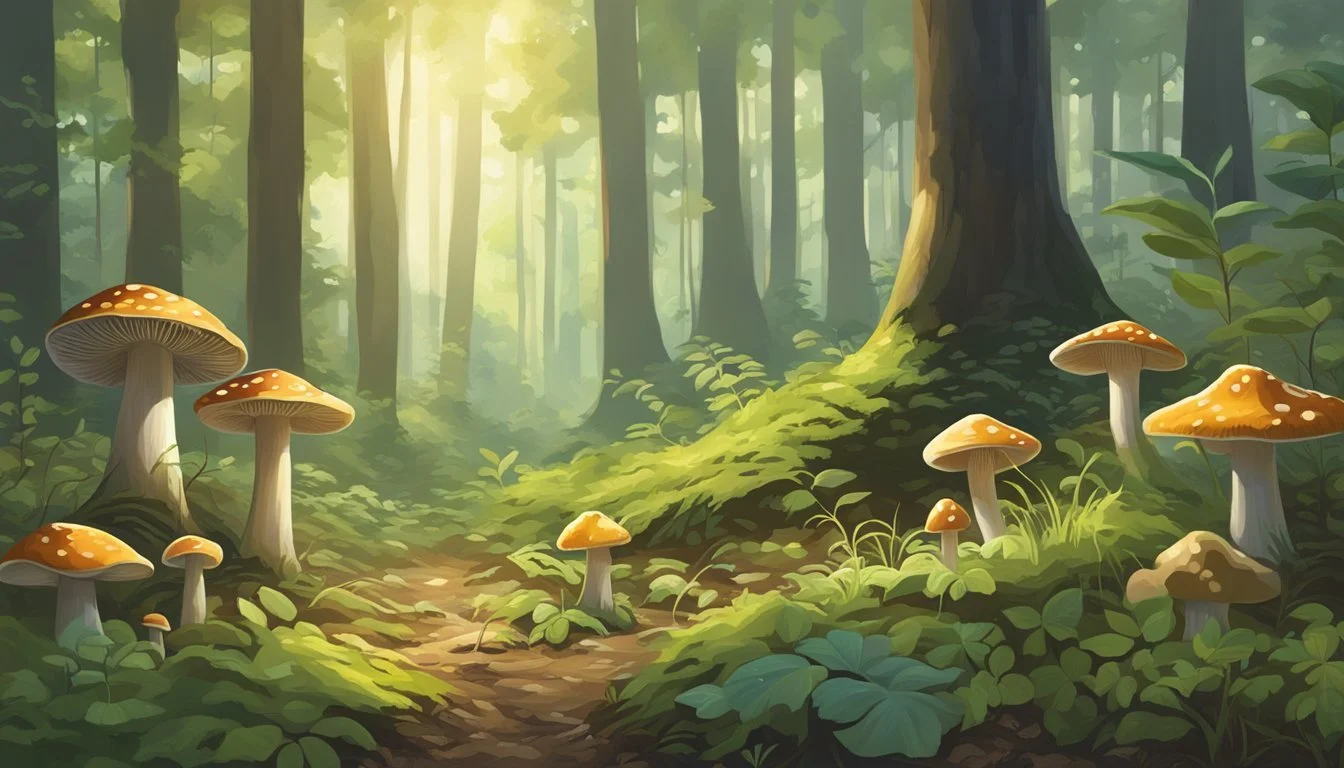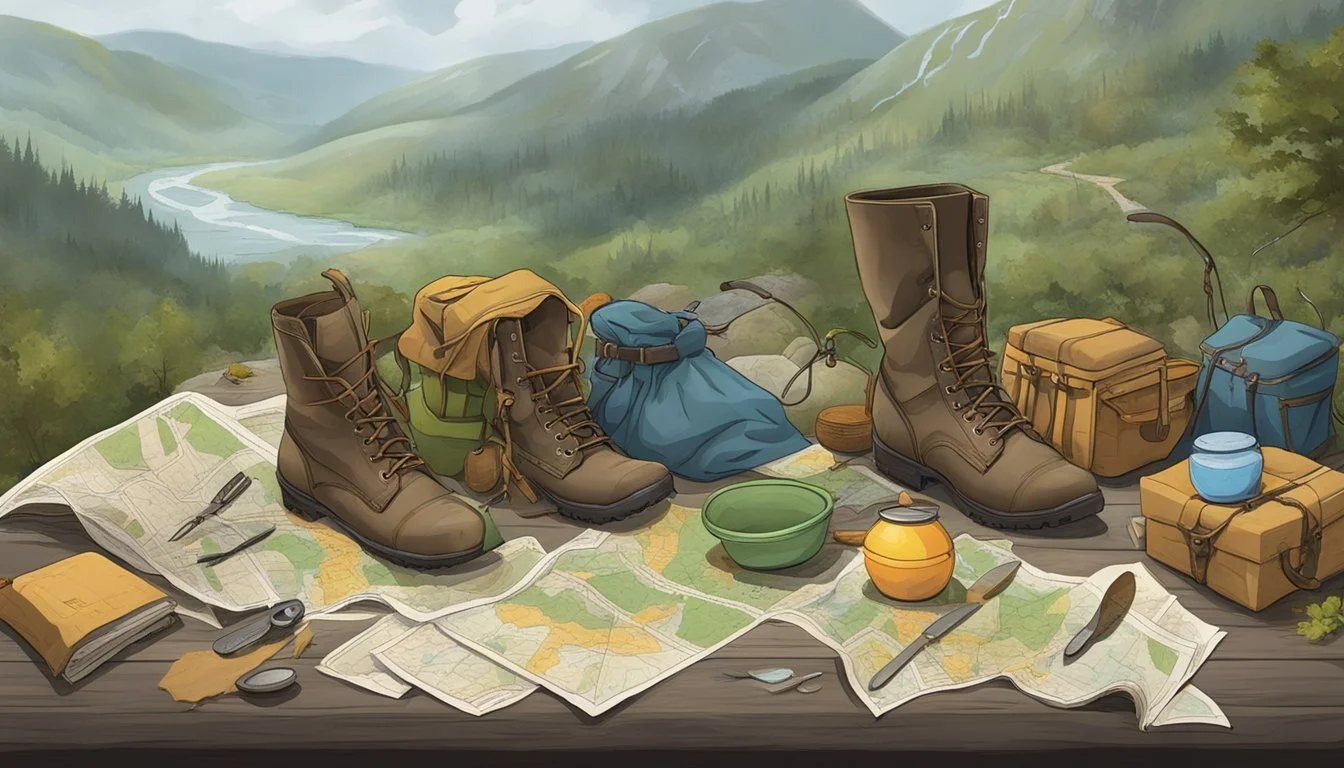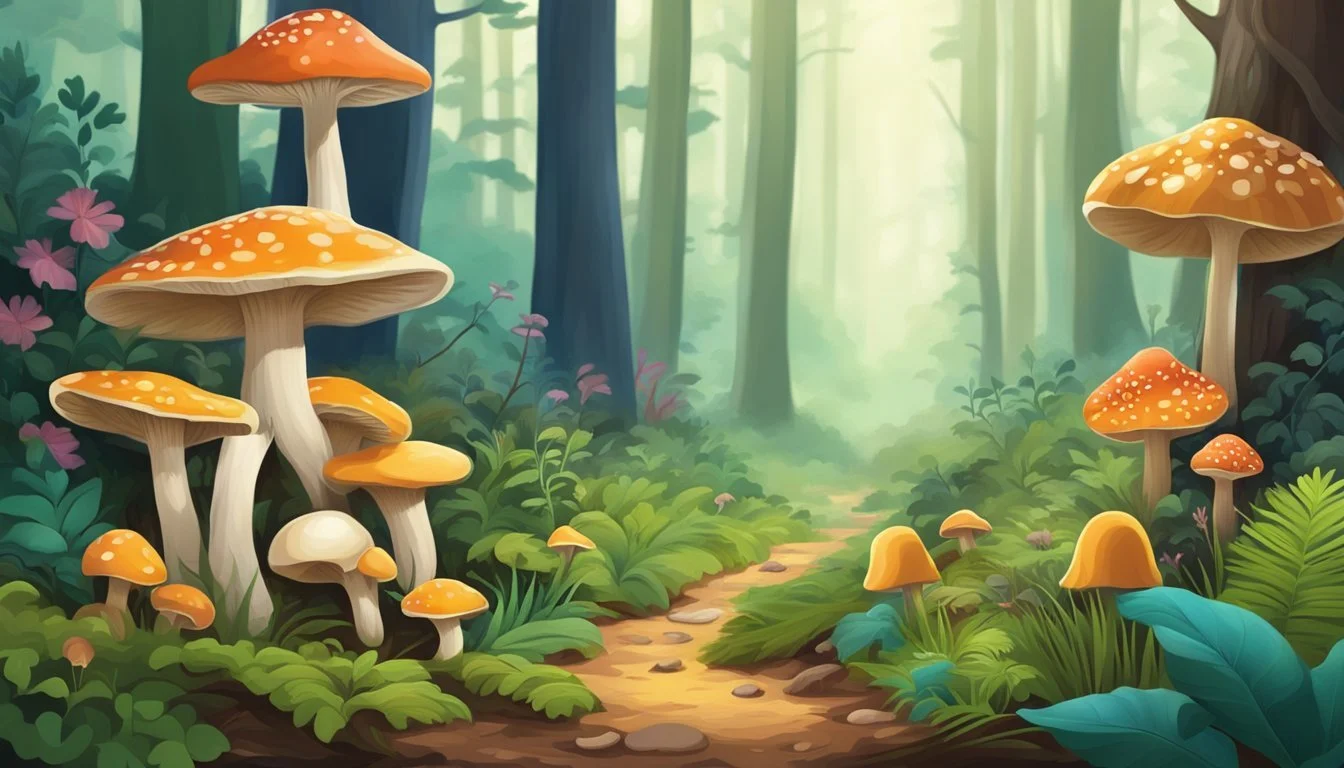Mushroom Hunting Ohio
Your Ultimate Guide to Foraging Safely
This Article is Part of Our Guide on Mushroom Hunting for All 50 States
Mushroom hunting in Ohio offers a blend of outdoor adventure and the chance to discover a variety of fungi found across the state. With thousands of types of mushrooms, including both edible and non-edible species, Ohio provides fertile grounds for both novice and experienced foragers. The activity attracts many enthusiasts who explore the state parks and forests, especially during the spring when the search for morels, a highly sought-after mushroom, is at its peak.
Each year, as the weather warms, Ohio's fields and forest floors transform into hotspots for mushroom hunters. The state is particularly known for its morel mushrooms, which come in several varieties such as black, white or gray, and big yellow morels, each with its own season and unique conditions for growth. Black morels are typically the first to emerge and are more challenging to locate, while the big yellow morels, though easier to spot, are regarded as the most coveted among collectors for their size and flavor.
The Ohio Department of Natural Resources provides guidelines and advice to mushroom hunters to ensure a safe and lawful foraging experience. As such practices are subject to rules and regulations, it is important for mushroom hunters to be informed about the appropriate procedures and to obtain any required permissions from relevant offices before engaging in foraging activities. The Ohio Mushroom Society also plays a significant role, organizing guided hunts and educational events throughout the year to support and educate the mushroom-hunting community.
Foraging for More Than Just Mushrooms in Ohio
Ohio's rolling hills and lush forests are a forager's delight, offering a bounty of wild edibles beyond the well-known mushrooms. From the shores of Lake Erie to the Appalachian foothills, the Buckeye State's diverse landscapes provide a variety of nuts, berries, greens, and roots. Discover the joys of foraging and reconnect with nature's abundance in Ohio.
👉 Foraging for Wild Edibles in Ohio
Commonly Found Edible Mushrooms in Ohio
Ohio is home to several edible mushroom species. Some of the most commonly found edible mushrooms in the state include:
Morel (Morchella spp): Often found in Ohio, morel mushrooms have a distinctive honeycomb appearance and are prized for their rich, earthy flavor.
Chanterelle (Cantharellus spp): These golden to yellowish-orange mushrooms are commonly found in wooded areas in Ohio and have a delicate, fruity aroma and a mild, peppery taste.
Chicken of the Woods (Laetiporus spp): Often found on decaying hardwood trees in Ohio, these bright orange shelf-like mushrooms have a soft texture and a flavor reminiscent of chicken.
Hen of the Woods (Grifola frondosa): Also known as maitake, these large, frilly mushrooms grow at the base of oak trees in Ohio and have a rich, earthy flavor and a meaty texture.
Oyster Mushroom (Pleurotus spp): Commonly found growing on dead or dying hardwood trees in Ohio, oyster mushrooms have a delicate flavor and a velvety texture, making them a versatile culinary ingredient.
Meadow Mushroom (Agaricus campestris): It grows in grassy areas after rain in late summer and autumn and is distinguished by its white cap and pink to brown gills beneath.
Giant Puffball Mushroom (Calvatia gigantea): These massive mushrooms appear in late summer and fall, are white and round, and must be consumed only when the flesh is pure white and firm.
It is essential to properly identify any mushroom before consuming it, as some species can be poisonous. Beginners should go mushroom hunting with an experienced guide or join a local mycological society to learn how to identify edible mushrooms safely.
Basics of Mushroom Hunting
Mushroom hunting in Ohio is an engaging activity that requires an understanding of fungi biology, the ability to distinguish between edible and poisonous mushrooms, and adherence to safety measures during foraging.
Understanding Mushroom Biology
Fungi are a diverse group of organisms that are essential to many ecosystems. Mushrooms are the reproductive structures of some fungi, and they release spores to propagate. These spores give rise to new fungal colonies. The parts of a mushroom are important for identification; they typically include a cap, gills or pores underneath, and a stem.
Identifying Edible vs. Poisonous Mushrooms
When foraging, differentiating between edible and poisonous mushrooms is crucial for safety:
Edible Mushrooms: Have distinctive features that experienced hunters recognize. It's important to learn these characteristics.
Poisonous Mushrooms: Can resemble edible varieties. Consuming them can be harmful or fatal.
Table 1: Quick Comparison
Feature Edible Mushrooms Poisonous Mushrooms Gills Vary by species May appear similar to edible types Stem Vary by species May have a ring or bulb at the base Spores Depend on species Can be white or colorful
Foraging Best Practices and Safety
Safety in mushroom foraging involves several best practices:
Permission: Always seek permission before foraging on private or public lands.
Guidelines: Follow state regulations and guidelines for sustainable foraging.
Resources: Utilize local resources, like the Ohio Department of Natural Resources, for information and updates.
Note: These sections are formatted and structured to convey the relevant details in a concise and clear manner, following the requested tone of voice and English language. Tables and lists are used where appropriate to present information in an organized way.
Mushroom Species in Ohio
Mushroom Hunting Seasons and Locations
Mushroom hunting in Ohio offers enthusiasts the opportunity to explore various habitats during specific seasons. Adherence to state regulations is required for a successful and legal foraging experience.
Seasonal Guide for Ohio Mushroom Hunting
Ohio's climate presents distinct seasons that are pivotal for mushroom hunters to consider. Spring typically ignites mushroom activity, with morels being the sought-after species from late March through June. Heading into late summer to early winter, hunters can find species such as the Ringless Honey Mushroom across different regions of the state.
Spring (March-June): Ideal for morels
Summer to Winter (Late summer to early winter): Time for Ringless Honey Mushroom and others
Prime Mushroom Habitats
Mushrooms in Ohio flourish in varied environments, but they are commonly found in forests, fields, and lawns. These fungi favor areas with ample moisture and rich soil content. Environmental conditions change with seasons, influencing the types of mushrooms that can be found. For instance, the forest floors and field areas of Ohio state parks and forests provide productive grounds for mushroom growth during the right conditions.
Habitats include: Forests, fields, lawns
Require: Moisture and good soil content
State Parks and Private Property Regulations
Foraging in state parks in Ohio is generally permitted, but gatherers should verify and comply with the specific regulations of each park. Some areas may require permission or have restrictions in place to protect the environment and maintain ecological balance. When considering private property, obtaining explicit consent from landowners is mandatory to ensure legality and respect for private lands.
State Parks: Check individual park regulations before foraging
Private Property: Must obtain permission to hunt mushrooms
Preparing for a Mushroom Hunting Trip
Before embarking on a mushroom hunting adventure in Ohio, one needs to secure the proper equipment and have a clear plan in place. A well-prepared forager increases their chances of a successful and safe experience in nature.
Equipment and Gear
The right gear ensures safety and convenience during a foraging trip. Essential items include:
Knives: A sharp knife is crucial for cutting mushrooms from their stalks.
Basket or Mesh Bag: These allow for proper ventilation which can prevent the mushrooms from becoming soggy.
Field Guide: A local mushroom identification guide assists in distinguishing edible species from toxic ones.
Compass and Map/GPS: These are necessary for navigation, reducing the risk of becoming lost.
Appropriate Clothing: Long sleeves and pants protect against insects and thorny plants.
Planning Your Route
A well-planned route contributes to the efficiency and enjoyment of the hunt. Researchers can:
Research Locations: Look for areas known for mushroom growth, such as state parks or forests.
Check Regulations: Ensure foraging is allowed and gain any necessary permits.
Weather Considerations: Optimal conditions often occur after rain and in mild temperatures.
What to Look for When Foraging
Identifying mushrooms requires attention to detail and an ability to recognize key characteristics:
Cap and Stem: Note the color, shape, and texture, as these can indicate species.
Gills and Spores: Observe the gill pattern and spore color by conducting a spore print.
Habitat: Different species thrive in varying environments; some prefer decaying wood while others may be found in open fields.
Proper preparation sets the stage for a fulfilling foraging excursion.
Processing and Consuming Mushrooms
When processing and consuming mushrooms gathered from the wild in Ohio, one must be meticulous in cleaning and preserving, utilize proper cooking techniques, and be acutely aware of the health benefits and potential risks involving edible and toxic varieties.
Cleaning and Preserving Mushrooms
Upon harvesting, mushrooms should be cleaned promptly to remove dirt and organic debris. Fresh mushrooms can be gently brushed or wiped with a damp cloth. It’s important not to wash them under running water as they are highly porous and will absorb moisture, which could affect their texture and flavor. Edible mushrooms should be stored in the refrigerator in a paper bag, which allows them to breathe and stay fresh longer. For long-term preservation, mushrooms can be dried, frozen, or pickled, each method retaining the distinct color and flavor profile of the fungus.
Cooking and Recipes
Mushrooms can be a delicacy in the kitchen, lending their unique flavors and textures to a variety of recipes. They should be cooked at the right temperature and for the appropriate duration to enhance their taste and ensure they are safe to eat. Some common methods for cooking include:
Sautéing: Quick and flavorsome way to cook mushrooms, often with onions and garlic.
Grilling: Ideal for meatier varieties, enhancing their smoky taste.
Roasting: Elevates the natural earthiness of mushrooms.
A basic recipe might involve sautéing sliced mushrooms in butter with herbs until they’ve browned, perfect to serve on top of toast or as a side dish.
Health Benefits and Risks
Mushrooms are renowned for their nutritional value, offering a source of protein, fiber, vitamins, and minerals with very few calories. They also contribute to a variety of health benefits, including support to the immune system. However, the risks can be severe when it concerns toxic mushrooms. Some mushrooms can be mistaken for edible ones, leading to symptoms ranging from mild gastrointestinal distress to life-threatening toxicity. Therefore, identification must be carried out with absolute certainty, often with expert consultation, prior to consumption.
Mushroom Ecology and Conservation
Mushroom hunting in Ohio is both an engaging recreational activity and a practice that requires awareness of fungal ecology and the importance of conservation. Effective management and sustainable harvesting are key to preserving the delicate balance within diverse habitats.
Understanding Mycology
Mycology, the study of fungi, reveals the complex life cycles and reproductive strategies of mushrooms. Fungi thrive in various habitats by decomposing organic matter, a process facilitated by their mycelium — the network of thread-like hyphae that absorbs nutrients. Ohio's diverse ecosystems support over 2,000 mushroom species, each with unique roles within their ecological niches.
Conservation Efforts and Sustainability
Responsible mushroom hunting involves adhering to guidelines that ensure species are not overharvested and habitats are not disturbed. Conservation efforts focus on:
Habitat preservation: Protecting the integrity of forests and fields where mushrooms grow.
Sustainable harvesting: Picking mushrooms in a way that does not damage the mycelium and allows for regeneration.
Role of Fungi in the Ecosystem
Fungi serve as critical decomposers in the ecosystem, recycling nutrients back into the soil and supporting plant growth. They form symbiotic relationships with tree roots through mycorrhizal networks, enhancing water and nutrient uptake for their plant hosts. The preservation of fungal communities is thus essential for the health of Ohio’s forests and fields.
Community and Resources
The Ohio mushroom hunting community offers numerous resources for both novice and experienced foragers. They include a dedicated society for mycology enthusiasts, various events and gatherings focused on mushrooms, and expert-led resources that answer frequently asked questions.
Joining the Ohio Mushroom Society
Those interested in mushroom foraging in Ohio should consider joining the Ohio Mushroom Society. This organization provides a platform for mycology enthusiasts to share knowledge, partake in foraging activities, and connect with fellow mushroom hunters. Membership benefits often include access to exclusive workshops, educational materials, and field trips.
Events, Festivals, and Social Gatherings
Throughout the year, Ohio hosts festivals and events centered around mushrooms and foraging. These events serve as an excellent opportunity for community members to learn, socialize, and enjoy the diverse world of fungi. Events range from the annual Morel Mushroom Festival to local meetups and forays conducted by the Ohio Mushroom Society. Attendees can expect to participate in guided hunts, cooking demonstrations, and identification sessions.
Frequently Asked Questions and Expert Advice
For those looking for guidance, the Ohio Mushroom Hunting Guide is a valuable resource that addresses frequently asked questions. It covers topics such as seasons for specific mushrooms, finding edible and toxic varieties, and best practices for sustainable foraging. The guide imparts wisdom from seasoned experts and provides the foundational knowledge needed for a safe and rewarding mushroom hunting experience.
Ethics and Legal Aspects of Mushroom Hunting
When engaging in mushroom hunting in Ohio, enthusiasts must navigate a series of ethical and legal standards to ensure they are respectful of the environment and compliant with state regulations.
Trespassing and Property Laws
In Ohio, mushroom hunters must always gain permission before entering private property. Trespassing on land without owner consent is illegal and subjects the individual to potential prosecution. It's imperative that they respect property boundaries and abide by posted signs regarding access.
Permission: Secure verbal or written permission from landowners.
Signage: Heed any 'No Trespassing' or similar signs.
Sustainable Harvesting Practices
Sustainable harvesting is crucial to protect Ohio's native ecosystems and ensure that mushroom populations thrive for years to come.
Off-Trail Collecting should minimize impact, which includes:
Only taking what will be immediately used; never overharvest.
Avoiding picking rare or endangered species.
Regulatory Compliance and Permits
Those hunting for mushrooms must familiarize themselves with the regulations that govern the harvesting of wild fungi within Ohio.
Key Regulatory Points Include:
State Parks and Forests: Typically allow mushroom hunting for personal use, but rules may vary.
Permits: Some areas may require permits; check with local parks or forestry offices.
Mushroom hunters have to ensure that their activities are in line with state laws to avoid penalties and contribute to conservation efforts.








